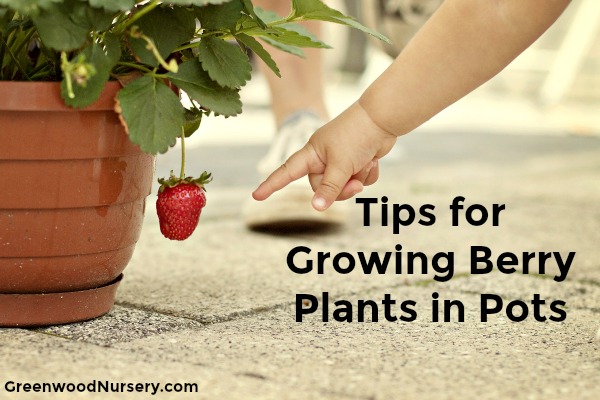Free gardening gloves when you spend $75.00 or more!

Although fruiting plants and bushes usually berry most bountifully when set in the ground, not everyone has the acreage and time to grow them there. And it is easier to grow a berry plant in pots than groups of plants in the landscape.
So, if your space and patience both are limited, you may want to start looking for large pots or grow-bags. To grow strawberries, you will need a container at least 10 inches in diameter, in the 16 to 18 inch range to grow a goji berry shrub, and at least a 24 to 26 inch container for a blackberry, raspberry, or elderberry bush. A half-barrel usually is about 25 inches wide, making it ideal for growing berry shrubs and strawberry plants.
Drill drainage holes in the base of any barrel or pot which doesn’t have them already. (Grow-bags with porous sides shouldn’t require such openings.) If the holes are large, you may want to cover them with some sor of screening to prevent your soil from seeping such as screen, broken tiles or gravel.
Place your pot or grow bag in a setting which receives at least 6 to 8 hours of sunlight per day. It’s a good idea to position pot feet or a plant caddy beneath that container, to prevent its occupant from sending roots through drainage holes or fabric into the ground. Spread 1 to 2 inches of gravel in the bottom of the pot or bag before adding your damp potting mix. Whatever mix you use should be light enough to be free-draining, but heavy enough to keep your plants from keeling.
Because most berry bushes prefer mildly acidic soil, you may want to use a combination of 2 parts coco coir, 1 part ground fir bark, 1 part composted manure, and 1 part sharp sand. (The manure must be well composted or it can burn your plants.) Since blueberries prefer highly acidic soil, you’ll need 3 parts of the peat moss or coir for them.
Because the roots of potted plants aren’t well insulated, you’ll want to choose extremely hardy varieties for container culture. And, unless you plan to grow more than one sort of each fruit, you’ll need types which are self-fertile too (i.e. don’t require another cultivar for adequate pollination.)
Plants which continue to flower and fruit for most of the summer will contribute more to your landscape and table than those which only make one crop per year. The ever-bearing “Ozark Beauty” strawberry, for example, and the twice-bearing ‘Sweetheart’ blueberry both can keep produce-ing.
After setting your plant at the same depth it grew in its nursery container, pat your planting mix snugly into place around it and cover that mix with a mulch of bark or gravel. You may also want to add a stake or trellis for plants such as the goji berry which are inclined to sprawl.
Although ever-bearing strawberry plants will begin flowering the same year they are planted, most berry bushes won’t begin doing so until at least their second summer. In the meantime you can read up on the care required for each type and enjoy the beauty of its foliage.
- cheryl's blog
- Log in or register to post comments







